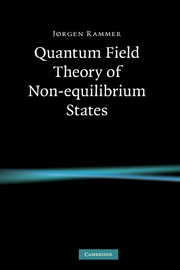Book contents
- Frontmatter
- Contents
- Preface
- 1 Quantum fields
- 2 Operators on the multi-particle state space
- 3 Quantum dynamics and Green's functions
- 4 Non-equilibrium theory
- 5 Real-time formalism
- 6 Linear response theory
- 7 Quantum kinetic equations
- 8 Non-equilibrium superconductivity
- 9 Diagrammatics and generating functionals
- 10 Effective action
- 11 Disordered conductors
- 12 Classical statistical dynamics
- Appendices
- Bibliography
- Index
9 - Diagrammatics and generating functionals
Published online by Cambridge University Press: 24 December 2009
- Frontmatter
- Contents
- Preface
- 1 Quantum fields
- 2 Operators on the multi-particle state space
- 3 Quantum dynamics and Green's functions
- 4 Non-equilibrium theory
- 5 Real-time formalism
- 6 Linear response theory
- 7 Quantum kinetic equations
- 8 Non-equilibrium superconductivity
- 9 Diagrammatics and generating functionals
- 10 Effective action
- 11 Disordered conductors
- 12 Classical statistical dynamics
- Appendices
- Bibliography
- Index
Summary
At present, the only general method available for gaining knowledge from the fundamental principles about the dynamics of a system is the perturbative study. According to Feynman, as described in Chapter 4, instead of formulating quantum theory in terms of operators, the canonical formulation, for calculational purposes quantum dynamics can conveniently be formulated in terms of a few simple stenographic rules, the Feynman rules for propagators and interaction vertices.
In Chapters 4 and 5, we showed how to arrive at the Feynman rules of diagrammatic perturbation theory for non-equilibrium states starting from the Hamiltonian defining the theory. The feature of non-equilibrium states, originally carried by the dynamical indices, could be expressed in terms of two simple universal vertex rules for the RAK-components of the matrix Green's functions. We are thus well acquainted with diagrammatics even for the description of non-equilibrium situations. However, for the situations studied using the quantum kinetic equations in Chapters 7 and 8, only the Dyson equation was needed, i.e. the self-energy, the 2-state one-particle irreducible amputated Green's function. No need for higher-order vertex functions was required, and the full flourishing diagrammatics was not put into action. In this chapter we shall proceed the other way around. We shall show that the diagrammatics of a physical theory, including the description of non-equilibrium states, can be obtained by simply stating quantum dynamics, the superposition principle, as the two exclusive options for a particle: to interact or not to interact! From this simple Shakespearean approach we shall construct the Feynman diagrammatics of non-equilibrium dynamics.
- Type
- Chapter
- Information
- Quantum Field Theory of Non-equilibrium States , pp. 253 - 312Publisher: Cambridge University PressPrint publication year: 2007



